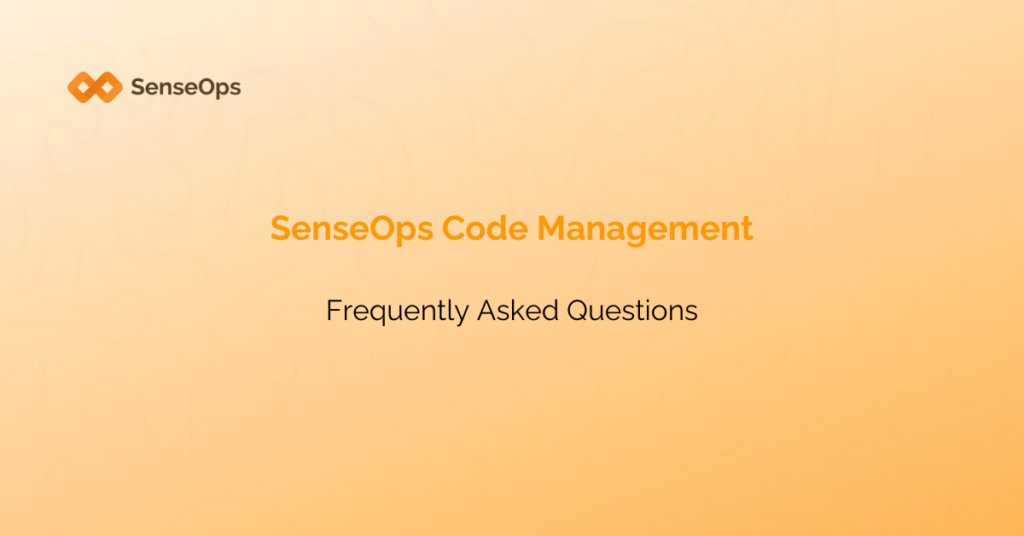FAQ's About Qlik Sense Version Control
Posted on 3rd Sep, 2025 | By Admin

SenseOps Code Management helps you track changes, manage versions, and collaborate with multiple developers on Qlik Sense apps without conflicts. It also allows you to govern code across environments in a single platform, making deployments faster, keeping apps secure, and ensuring your team stays aligned.
In this article, you’ll find answers to common questions about SenseOps Code Management and how it can make managing Qlik apps easier for your team.
Quick Links
1. Can I track changes done to my Qlik apps?
You can track and compare changes between Qlik app versions using SenseOps Code Management. It gives you visibility on all versions at granular levels.
- See changes in scripts, expressions, visuals, connections, and extensions
- Review code and govern multiple versions with ease

2. Can SenseOps track multi-developer changes simultaneously?
Yes. SenseOps Code Management lets multiple developers work on the same Qlik app at the same time. Each developer works in their own branch, commits changes there, and then the manager reviews and merges everything into the master version.
3. Does the user need to create or commit Qlik versions manually?
No, SenseOps manages versioning automatically when developers commit their changes.
4. How do I prevent conflicts when multiple developers work on the same app?
Each developer works in a separate branch of same or different Qlik apps. Managers review merge requests, and approve/reject requests to resolve conflict.
5. How does SenseOps prevent unauthorized deployments?
SenseOps prevents unauthorized deployments by using role-based access controls.
- Developers: Can create and modify apps but can’t deploy to production unless permitted.
- Managers: Creates projects for teams, assigns roles, and access. Can review changes and approve deployments.
- System Admins: Have full deployment rights and control over permissions.
- Promoters: Runs Jobs & Packages. Rolls back Jobs/Packages and activates CI/CD.
6. Can code comparison be made between any two versions at any time?
Yes, with SenseOps, you can compare code between any two Qlik Sense versions at any time.
7. How will the reviewer get to know the timely reviews?
In SenseOps, Reviewers get alerts or notifications whenever a review is pending. So, they always know what needs their attention and by when.
8. Can development happen in the on-prem version and deployment happen in the cloud?
Yes. With SenseOps, you can develop apps in your enterprise/on-prem Qlik Sense environment and then deploy them to the cloud.
9. How are the roles and access permissions managed in SenseOps?
Developers
- Create repositories
- Make commits and create branches/versions
- Send merge requests and compare versions
Managers
- Assign roles and create projects
- Inspect merge conflicts
- Approve or reject requests
- Create jobs and packages
- Define CI/CD pipelines
Promoters
- Run jobs and packages
- Roll back changes
- Activate CI/CD pipelines
System Admins
- Full access (includes all other roles)
- Create environments and manage connectivity
10. Is there a faster way to move Qlik apps from development to production?
Yes, with SenseOps, teams can move Qlik apps quickly from development to production – All with single-click build progression.
11. Can SenseOps Code Management integrate with our existing DevOps or IT workflows?
Yes. SenseOps Code Management integrates seamlessly with your existing DevOps and IT workflows.
12. What are Projects? Are they different from Streams?
Projects in SenseOps are where teams build and manage Qlik apps, like handling versions and branches.
A Stream in Qlik, on the other hand, is a publishing area where apps are shared with end users.
13. How does SenseOps help in deployment workflows?
SenseOps streamlines deployment by automating tasks, managing approvals, and tracking changes. Teams can schedule jobs, run CI/CD pipelines, and promote or roll back apps with a single click, making deployments faster. View detailed Qlik Sense Version Control & Deployment Documentation.
14. What is the Loop and Reduce feature in SenseOps?
Loop and Reduce optimizes app size during deployment, lowering server load and making deployments faster.
15. Can I maintain documentation from releases to production?
Yes. SenseOps lets you keep track of all releases with clear documentation. You can record changes, deployments, and approvals, making it easy to refer back and audit when needed.
16. Are approval workflows supported before changes go live in production?
Yes. SenseOps supports approval workflows, allowing managers to review and approve changes before they are promoted to production.
17. Can I roll back my current version in production?

Yes. SenseOps allows you to roll back to a previous version in production.
18. We use GitHub for code backups? Does SenseOps have connectivity to GitHub?
Yes. SenseOps works with local and cloud repositories so you can sync, manage versions, and back up code easily.
19. Does SenseOps work with GitHub, GitLab, or Bitbucket?
Yes. SenseOps can connect to GitHub, Bitbucket, GitLab, and Azure DevOps.
20. How is the user onboarding process managed in SenseOps?
In SenseOps, new users are added and assigned roles like Developer, Manager, Promoter, or Admin, so they only get access to what they need.
21. Does SenseOps scale better for large teams or enterprises?
Yes, SenseOps is designed to support large teams and enterprises effectively. It offers role-based access control, automated workflows, integration capabilities, and scalability.
These features make SenseOps a robust solution for scaling operations in larger environments.
22. What is the best option for version control in Qlik Sense?
SenseOps is the ideal solution for Qlik Sense version control. It lets teams:
- – Manage apps, mashups, and extensions efficiently
- – Create and manage multiple branches for parallel development
- – Review and merge changes with merge requests
- – Resolve conflicts easily at the sheet or object level
- – Deploy code across environments with a single click
- – Integrate with CI/CD tools to automate delivery